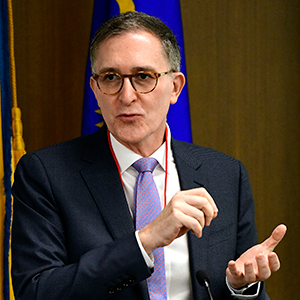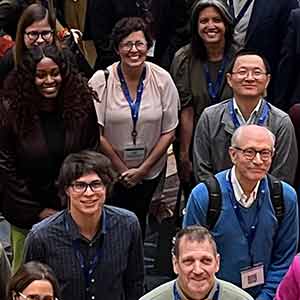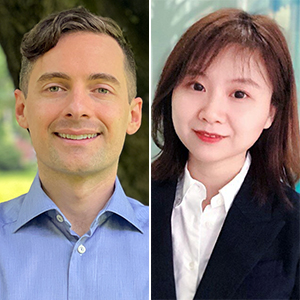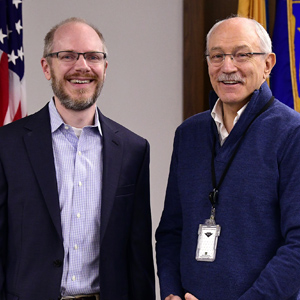In this inaugural director’s column, I would like to share with you what makes me tick — the leadership philosophy I bring to my new role as head of NIEHS and the National Toxicology Program. My philosophy is based on five guiding values for achieving the goals laid out in the institute’s Strategic Plan 2018-2023. These values are informed by my personal and professional experiences, as well as my passion for leading this world-class research organization. They also reflect what I learned during many listening sessions with staff and stakeholders.
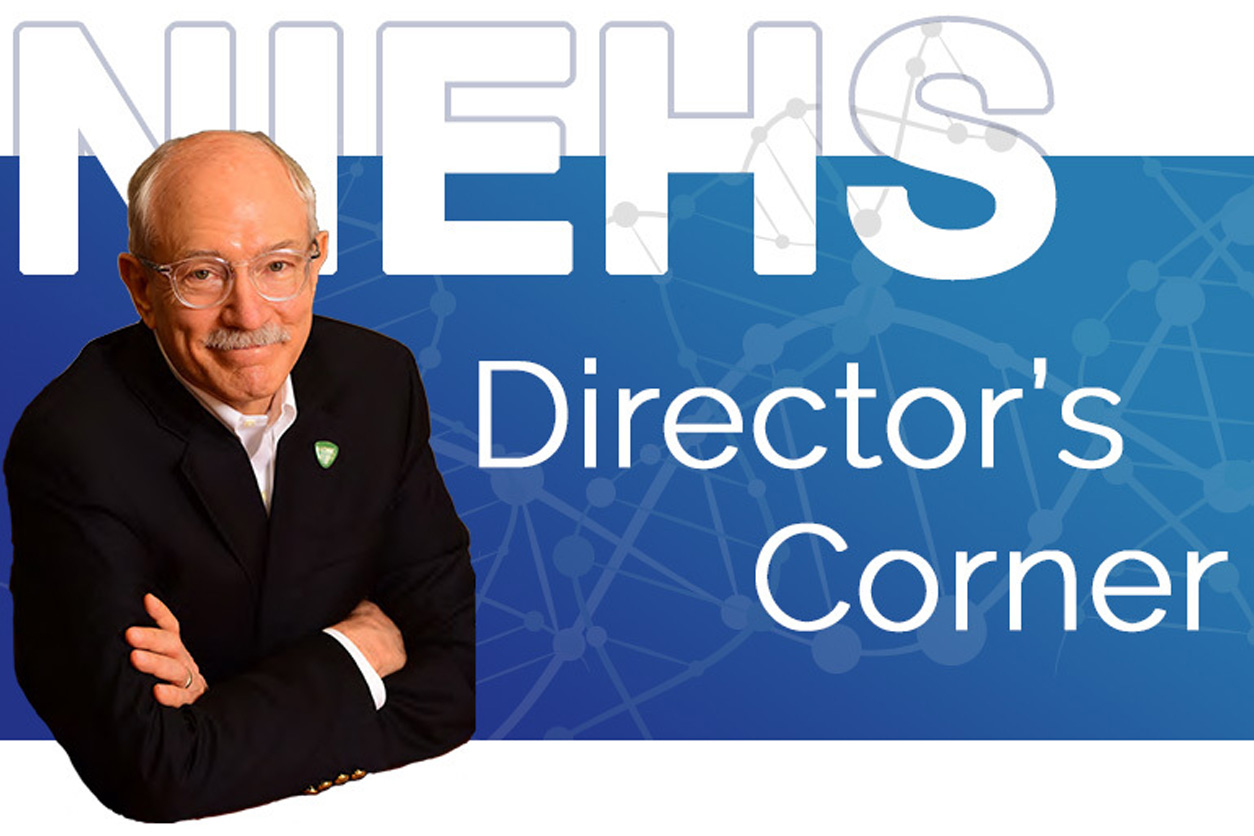 Welcome to the Director’s Corner, a monthly column that I hope will spark dialogue across the environmental health sciences community and open doors for research collaboration. (Image courtesy of NIEHS)
Welcome to the Director’s Corner, a monthly column that I hope will spark dialogue across the environmental health sciences community and open doors for research collaboration. (Image courtesy of NIEHS)At NIEHS, we aim high in all that we do. Our mission is to study how the environment affects people, to promote healthier lives. Our vision statement calls on us to help prevent disease and disability — an objective that I believe is especially important. Our strategic plan brings clarity and detail to those goals, providing the framework for future success.
In my view, for bold mission statements and strategic plans to be more than just words on a page, leaders must inspire trust, mutual respect, open dialogue, and common purpose.
I hope that the values outlined below — all equally important — enable us to do more together than any one of us can do alone. They will empower each of you to share your talents and contribute your perspectives. They will support new lines of communication that help us take advantage of our collective expertise, achieve our scientific goals, and ensure the environmental health sciences community continues to reach new heights.
 I believe that environmental health scientists can collaborate with genomics researchers to expand our knowledge of disease and improve public health. (Photo courtesy of PopTika / Shutterstock.com)
I believe that environmental health scientists can collaborate with genomics researchers to expand our knowledge of disease and improve public health. (Photo courtesy of PopTika / Shutterstock.com)The coming decade holds great promise. Discoveries by NIEHS researchers and grantees will provide important insights into how environmental exposures can influence human biology. That knowledge will lead to new approaches for promoting health and warding off disease.
For example, as we study how the environment interacts with our genes through genetic and non-genetic mechanisms, we will likely spur breakthroughs in precision health. This will provide individuals with personalized guidance on how to stay healthy, based on their unique biology.
Our work is more important now than ever.
Encourage strong leadership at all levels
I am committed to what I call distributed leadership, which draws on valuable input from scientists and stakeholders across the environmental health sciences community. This approach will empower more individuals to share their unique perspectives, increase transparency and efficiency, and better prepare us to tackle the scientific challenges of the day.
Working in this way with the stakeholders worldwide, we developed the institute’s strategic plan, which is an excellent framework for moving environmental health sciences forward. My focus for the next several years will be to execute that plan. But I cannot do this on my own, and I will count on your contributions to help us achieve our ambitious goals.
Promote innovation
NIEHS has a proud history of success based on embracing innovation, but we can do even more. It is impossible for us to know how, when, or where the next transformative idea will emerge, so we need to foster an environment that promotes and rewards diversity of thought. Bold new ideas must be taken into consideration and given a fair hearing. We must be fearless and uninhibited in our pursuit of new knowledge.
 In my view, a research culture that supports diversity of thought will promote innovation by encouraging scientists to share new ideas that challenge the status quo. (Photo courtesy of jijoomathaidesigners / Shutterstock.com)
In my view, a research culture that supports diversity of thought will promote innovation by encouraging scientists to share new ideas that challenge the status quo. (Photo courtesy of jijoomathaidesigners / Shutterstock.com)Also, we should adopt the latest and greatest technological advancements from across the biomedical sciences. Developing new technologies and approaches will help to fill gaps in our current experimental designs. We need to establish a collective mindset in which we approach every idea as a gift that can be shared, built upon, and enhanced in a way that moves our critical research to the next level.
Nuture collaboration
The environment plays a key role in diseases and adverse health effects studied across the National Institutes of Health (NIH). I want to integrate our work assessing effects of environmental exposures into research involving the origins of disease.
Therefore, I will actively foster collaboration between environmental health scientists and researchers at other NIH institutes and federal agencies. The aim will be to increase knowledge of how the environment contributes to disease development, with the ultimate goal of enhancing efforts related to prevention and precision health.
For example, NIEHS promotes the concept of the exposome, which considers environmental exposures throughout an individual’s lifetime. This approach, when coupled with the genomics capabilities of the All of Us Research Program and other NIH initiatives, will broaden our understanding of conditions ranging from asthma to cardiovascular disease.
Enhance communication
At NIEHS, communication is key. It starts with how we interact with each other. We need to carefully think about how to express our ideas and actively listen to others. A kind word, a show of appreciation for a job well done, opening a door for a coworker — such small acts of decency can significantly improve organizational culture and performance.
Let us spread collegiality through communication that builds respect and goodwill.
 Enhancing scientific communication will help us share findings with the public and prevent disease, and it will make possible new research partnerships — a win-win situation. (Photo courtesy of GrAI / Shutterstock.com)
Enhancing scientific communication will help us share findings with the public and prevent disease, and it will make possible new research partnerships — a win-win situation. (Photo courtesy of GrAI / Shutterstock.com)Communicating our research also is critical. We need to find more ways to effectively share our discoveries with other scientists, the public, decision-makers, and community stakeholders. All of us, no matter our position at NIEHS, should strive to improve in this area. We need to make communication training part of our professional development. Doing so will lead to better health outcomes and foster greater scientific collaboration — a true win-win situation.
Strengthen workforce through diversity
We should strive to build the strongest possible workforce based on principles of diversity, equity, and inclusion. NIEHS will remain a global leader in discovery and innovation by supporting highly talented staff from a variety of backgrounds. Embracing these principles is at the heart of our future success.
A diverse, creative, and highly motivated workforce with a wide range of skill sets and viewpoints will keep us at the cutting edge of environmental health sciences research.
(Rick Woychik, Ph.D., directs NIEHS and the National Toxicology Program.)





